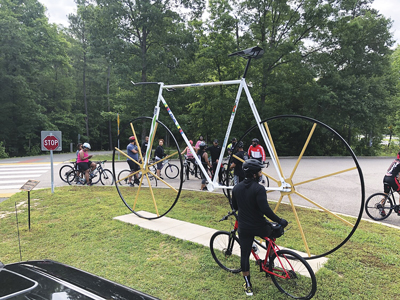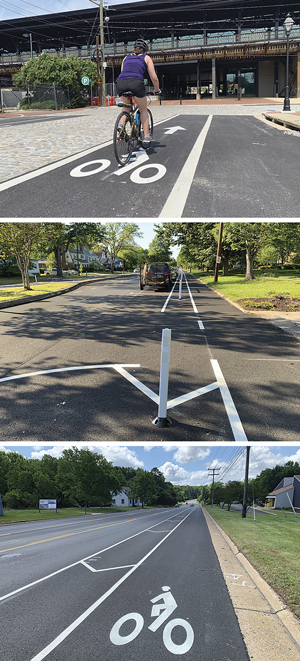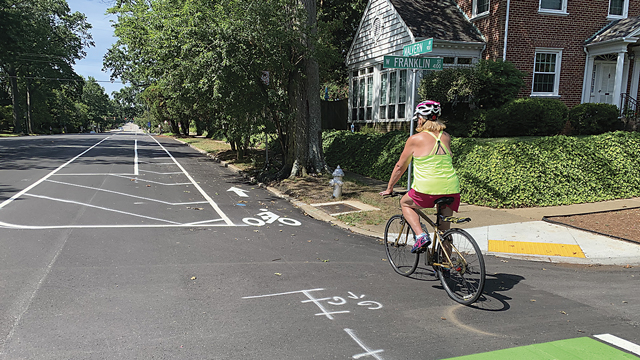If you ask Rafeeq Akbar of the Urban Cycling Group (UCG) why he got into cycling, he’ll tell you the pandemic was a big factor. He is a board member of the Richmond-based cycling club, which was founded in May 2020.
“Kyron Copeland and Derrick Rippy started with a ride on the Virginia Capital Trail,” Akbar said of the two founding members of the group. “That’s the exact reason we got started. Being stuck working out of the house, we said, ‘Let’s do something fun where we’re outside.’ Biking happened to be it. It was the pandemic that caused it. If it didn’t happen, we wouldn’t have done this.”

The number of people looking to ride bicycles for both recreation and transportation is on the rise. Thankfully, the number of safe places to bike in the region is also increasing. If you combine all of the designated and signed bike lanes and multi-use paths in the Richmond area, there are more than 150 miles of bicycle infrastructure. And that’s not counting park trails and private paths found in communities that have embraced the concept that a growing number of people want to live healthier lifestyles in walkable and bikeable neighborhoods.
Of course, a third of those miles can be found on the 52-mile Virginia Capital Trail, the popular non-motorized connection between Richmond and Jamestown that was completed in October 2015 after seven years of construction and nearly twenty-five years of planning.
The mostly rural trail is a recreational destination for cyclists because of the sights along historic Route 5, which is designated as a scenic Virginia byway. The Capital Trail has become a destination because it is a safe place to ride for most every kind of cyclist – from the youngest riders to senior citizens to inexperienced novices to the most accomplished and hardcore professionals. It is ten feet wide, paved, and separated from Route 5 with properly marked road crossings and signage. The Virginia Capital Trail Foundation has worked to provide parking areas and trailheads, bike repair stops, restrooms, and other amenities along the route to make riding easier and more enjoyable.
Bicycle traffic counters along the Capital Trail between the Canal Walk downtown and the Four Mile Creek Park trailhead in eastern Henrico average between 300 to 1,000 cyclists a day. While some of those counts are returning visitors, it is still an excellent indication of cycling traffic and biking popularity.
As one of those hardcore riders, I’ve ridden the Capital Trail dozens of times and spoken with many riders of all ages and experience levels during these past five years. Perhaps we’re just beginning to see the true success of the trail evolve as a recruiting tool for people in the Richmond area to become cyclists.
Encouraging Young Cyclists
New bike lanes can create new cyclists which in turn may help people develop healthier lifestyles and healthier communities.
Molly Brannan lives in Northside, not far from the new bike lanes on Brook Road. She and her husband, Dave Jones, have been doing their best to raise their two children, Soren, seven, and Maxine, five, to appreciate biking.
“With the pandemic, we all got bikes as a way to get outside,” Brannan said. Biking was one of the family’s ways to practice social distancing as a cure for cabin fever.
As a new cyclist, Soren was excited to attend a biking birthday party last year at the Belle Isle Pump Track, but it was canceled due to the pandemic. Undaunted, Brannan planned a family ride on the Capital Trail starting at Great Shiplock Park in Shockoe Bottom, which includes a steep hill climb at Tree Hill just east of Rocketts Landing.

“We did about five miles out and back,” she said, “He hated the hill, which was a little too much for him. But he got to bomb down on the way back and loved that.”
Brannan said the family enjoyed being out on the Capital Trail so much they dedicated extra free time during the pandemic to divide the trail into segments. They eventually conquered the full fifty-two miles.
“We’d ride our five to six miles out and back and eventually did the whole thing,” she said, adding that Soren loved it and gained a lot of confidence and stamina with these rides.
Over the past year, biking has become a habit and the family’s favorite way to get around. Brannan said they ride the Brook Road bike lanes for some errands and when they visit the Ginter Park Library. They have built their way up to riding about four miles from Northside to the Capital Trail using neighborhood streets and connecting to the Cannon Creek Greenway – a mile-long, separated multi-use trail in Highland Park – to connect to Shockoe Bottom and down to the Capital Trail.
The Capital Trail hasn’t just benefited riders; it has been a boon for tourism and has had a positive impact on the local economy. An economic and impact study of the 2018-19 fiscal year conducted for the Virginia Capital Trail Foundation revealed that visitors to the trail spent an estimated $6.1 million throughout the Commonwealth with more than 90 percent spent within a 50-mile radius of the trail. The total economic activity stimulated by the trail in Virginia during that period was approximately $8.9 million, and nearly 95 percent occurred within that 50-mile radius.
A month before the Capital Trail opened in 2015, the Richmond region hosted the Union Cycliste Internationale (UCI) Road World Championships in September. The culmination of years of planning by area localities, especially the City of Richmond, this UCI event put Richmond on the bike destination map. While many Richmonders might not have known it, the UCI is one of the biggest international cycling events. A lasting legacy of 2015 is that it gave existing bike plans an energy boost to continue building more safe places to ride.
Biking with the Family 
Dana Morris also lives in Northside with her husband, Mike, and 8-year-old daughter, Piper. Morris said they have always enjoyed family bike rides, starting with Piper in a trailer pulled with their bikes, stepping up to a Trail-a-Bike, and now riding her own bike. Having safe places to bike has helped.
“We were so excited to have the Brook Road bike lanes built,” she said, noting that they can now ride safer and easier to their favorite places like Bryan Park through Bellevue or connect to downtown Richmond.
Morris is a proponent of biking for transportation in her community.
“Some people think two miles is really far away, but it’s really not that far to bike if you find a safe way to do it,” Morris said. “I hope that the city will connect it even more. Change is inevitable and if you want safer and more livable neighborhoods, make it easier to bike and walk.”
There is cause for concern with regard to safety. Since 2015, the Richmond area has averaged
approximately one hundred reported crashes involving cyclists per year, with thirteen of those crashes resulting in death, according to data collected by the Virginia Department of Transportation (VDOT). In Virginia, bicyclists and motorists basically have the same rights and the laws governing traffic regulation apply equally to both.
All those yellow “Share the Road” signs and painted bicycle sharrow markers (shared lane) on the roads we see out there make that clear, right?
Maybe not for everyone. Cyclists can wear all the bright clothing they want and cover their bikes in lights, but the speed and weight differentials between bikes and motor vehicles are the real issues. Ultimately, providing more safe places to ride separated from faster vehicular traffic is the best remedy. Richmonders have seen the success of the east-west Virginia Capital Trail and now seek a north-south trail to continue building inviting new places for cyclists to ride.
That next big project is the Fall Line trail, which started as the Ashland to Petersburg Trail with a study conducted by VDOT that was completed in February 2020. Work has already begun on segments of the proposed 43-mile trail, which is expected to generally follow along the Route 1 corridor and would connect seven localities between Petersburg and Ashland, including Colonial Heights, Richmond, and the counties of Chesterfield, Henrico, and Hanover.
Just like with the Virginia Capital Trail, it will likely take more than a decade to complete the Fall Line. And since it is being developed along more densely populated corridors than rural Route 5, it will be accessible to many more residents and can provide a non-vehicular transportation network for the region.
Where Should We Ride?
While longer dedicated trails are nice, sometimes you just need to travel a couple of miles and a bike is the best way to get there. Being brave enough to ride calmer, low-traffic neighborhood streets is usually not a problem for most cyclists, but venturing beyond them may require crossing or connecting along a busier roadway. Transportation planners in the Richmond area have been working to close those gaps by adding more bike lanes and trails.
The City of Richmond continues to fulfill the promises of the 2014 Bicycle Master Plan. One of the most transformative projects was the December 2016 opening of the popular T. Tyler Potterfield Bridge, a non-vehicular crossing of the James River downtown that connects Brown’s Island to Manchester.
Don’t have a bike? You can try RVA Bike Share. Since 2017, this system has offered electronic bicycles through their website, RVAbikes.com. RVA Bike Share consists of a network of twenty stations mostly central to downtown with 220 bikes. Riders can purchase anything from a one-way trip to an annual pass.

Also in the City of Richmond, several miles of new bike lanes have been added by a method called roadway reconfiguration (also called road diet) where travel lanes are converted from motorized traffic to bicycle lanes as a result of a repaving and re-striping effort. It’s more cost-effective than building new bike infrastructure from scratch, and localities do their homework to make sure they are selecting roadways with low traffic volumes in comparison to the number of travel lanes that may be repurposed during repaving for bike lanes or other safety implements and according to guidance from VDOT and the Federal Highway Administration.
More than three miles of bike lanes were added to Brook Road from Azalea Avenue all the way to Jackson Ward, a portion of which should eventually become part of the Fall Line. Through that same re-striping process, Richmond also added new bike lanes on Malvern and Patterson Avenues, a bike boulevard on 29th Street in Church Hill, and bike lanes on 1st and 3rd Streets downtown.
Plus, cyclists can finally bike under Main Street Station to connect between the Capital Trail by way of the 17th Street Farmers Market and East Franklin Street to get to Bank Street and Capitol Square. More projects are planned, including the long-awaited bike lanes on Forest Hill Avenue in Stratford Hills and Jahnke Road in Westover Hills. All told, the City has added more than thirty miles of new bike lanes as a result of the master plan and in the process, has built a much safer and inviting cycling network.
But it’s not just Richmond. Bike lanes don’t need to stop at the city limits. The surrounding counties have joined the effort, too.
Chesterfield County converted two miles of Turner Road between Midlothian Turnpike and Hull Street Road into bike lanes last year, and the Lucks Lane multi-use path should be completed this year. There are already more than fifty miles of designated bike lanes along roads like Robious, Courthouse, Charter Colony, Woolridge, Genito, Ironbridge, and more, though some of those routes may not be as inviting to families or people concerned about riding near 45 mph traffic.
As a result of road widenings and a new bridge over a rail line, Hanover has added short stretches of bike lanes in the areas near the Kings Charter neighborhood along Sliding Hill Road and Atlee Station Road near the public schools complex. Additionally, Ashland will be the first locality to finish its section of the Fall Line this spring.
In the past year, Henrico added short segments of bike lanes on Thamesford Way and Cedar Grove Way at the request of the neighborhoods. As Henrico updates its comprehensive plan, including seeking input from a new bicycle and pedestrian chapter, several more bike projects are under consideration that could include multi-use paths and roadway reconfigurations, including seven-and-a-half miles of the Fall Line, beginning with the 2-mile Lakeside Community Trail.
Social and Safe Cycling
Safety isn’t just part of where you ride. It is also how you ride, especially in groups.
The Urban Cycling Group grew quickly from the original handful of friends. As word spread through texting and social media, by the end of May 2020, Akbar said between twenty to forty cyclists were coming out for each planned ride, including many couples and families.
“In the beginning, we didn’t know what we were doing,” he said, since many were new to cycling and group bike rides. “We talked to bike shops, other bike groups, researched, and now we’re organized.”

As always, safety is a priority. UCG members encourage everyone to wear helmets, bring proper gear, and use bike lights when necessary. Communication is essential on group rides and all members learn hand signals and the proper verbal commands for group rides, like yelling “stopping” when lead cyclists approach stop signs and red lights.
Whether riding on trails or on public roads, group rides are safer when experienced riders look out for inexperienced riders, especially when passing through intersections and mixing with automobile traffic. At UCG, rides are broken down into smaller groups, from the faster and more experienced riders to the slower and least experienced novices. The group has bike ambassadors who help riders figure out which group might best match their skills.
They also do bike checks before rides. Akbar says it always helps when you plan ahead for bike repairs before hitting the road. “Most of our executive board carry kits in case someone breaks down, which is just part of the deal with group rides,” Akbar said.
The group has several planned routes, including rides along the Virginia Capital Trail and the battlefield roads in eastern Henrico; routes using bike lanes on Malvern Avenue, Hermitage Road, and Cannon Creek Greenway in Richmond; rides along the bike lanes in South Richmond on Ironbridge Road; routes along the signed US Bicycle Route 1 from Bryan Park through Lakeside to Ashland; and rides in the Petersburg area.
Richmond is becoming a much friendlier place to ride, but we all have to do our part to keep moving in the right direction. Support bicycle infrastructure projects with your localities and elected officials and be kind to cyclists when you drive. Whether you’re a solo cyclist, a group rider, or taking your family out for a spin, make time to plan your bike destination, choose the safe routes, and take care
on the roads.
photos: Phil Riggan, Urban Cycling Group, Karen Schwartzkopf




